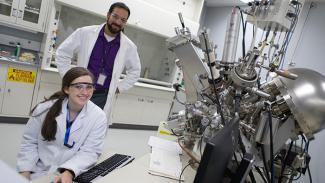Using an array of high-tech microscopy and X-ray diffraction capabilities, NETL researchers are discovering, developing and commercializing innovative technologies that allow the rearrangement of carbon dioxide (CO2) molecules – processes that can help protect the environment by reducing CO2 emissions and creating domestic supplies of fuels and chemicals that are used to benefit the economy.
A major challenge with using the nation’s abundant fossil fuel resources to power the plants that provide electricity to factories, businesses, homes, schools and hospitals has been the dilemma of how to reduce the resulting CO2. NETL has been at the forefront of work to find answers from capturing and storing the gas to developing technologies that can burn fossil fuels more efficiently and emit less CO2.
NETL’s Dushyant Shekhawat, Ph.D., and Douglas Kauffman, Ph.D., have followed a different approach – altering the very molecules that make up CO2 to change the gas into something useful. The trick is to identify the best catalysts to trigger the chemical reactions that alter molecules of the greenhouse gas. The best catalysts increase the rate of chemical reactions, are not consumed in the process, and can be used repeatedly.
“A chemical reaction is a process that leads to the chemical transformation of one set of chemical substances to another,” Kauffman said. “At NETL, we have developed a great deal of expertise for correlating catalyst structure with chemical reactivity.”
Shekhawat, who focuses on using the processes to reduce overall CO2 emissions, said the research team uses the Laboratory’s extensive technical capabilities to determine what catalysts work best, providing a detailed understanding of why a catalyst shows certain behaviors. The Laboratory has been prolific in the field, filing patents on eight separate technology innovations and spinning out a new company to further commercialize technologies.
“Once we have identified why a catalyst works well, we can optimize catalyst formulation to maximize performance and operational lifetime,” he said. “These efforts will ultimately allow more energy-efficient processes for reducing CO2 emissions.”
Shekhawat said that NETL’s characterization and evaluation capabilities are used to correlate the size, shape, crystallographic orientation, and electronic structure of catalysts with chemical reactivity.
“For example, spectroscopic techniques provide insight into the electronic structure and chemical state of the catalyst surface, while X-ray diffraction provides crucial information on the catalyst crystallinity” he said.
Kauffman, who works on processes to convert CO2 into useful products, added that “microscopic techniques, such as scanning tunneling microscopy and scanning electron microscopy, provide high resolution information on particle size, shape, and morphology. We also leverage other DOE user facilities to conduct synchrotron-based X-ray absorption, photoemission and diffraction that track catalyst changes in real time during reaction conditions.”
NETL researchers used their expertise and equipment to develop a patented catalyst for an electrochemical conversion process that uses gold nanoparticles composed of 25 gold atoms to electrochemically convert CO2 and water into synthesis gas, which is a versatile chemical feedstock used to produce a variety of industrially relevant chemicals. Electrochemical CO2 conversion systems have the additional benefit of using excess renewable energy resources to power them, providing “carbon neutral” or “carbon negative” products that do not produce additional CO2 emissions.
Another gold-based catalyst developed by NETL used visible light to convert CO2 into value-added chemicals. Small gold nanoparticles were paired with zinc oxide. Under illumination with visible light, the system’s temperature increased enough to convert CO2 into carbon monoxide or methane. The reactivity and chemical selectivity could be tuned by controlling the light intensity.
These innovations demonstrated that renewable energy resources and sunlight can efficiently power CO2conversion and hopefully lead to development of large-scale systems. But, precious metals like gold and platinum could present a cost barrier for large-scale deployment of electrochemical systems. Replacing them with newly discovered catalysts will lead to a less expensive process. NETL research is currently focused on developing catalysts from cheaper, earth abundant metals, such as copper, nickel and iron.
Another example of NETL’s work in the field was a successful innovation of a pyrochlore catalyst that is a promising technology for reducing emissions from long-haul truck idling. A pyrochlore is an isostructural metal oxide mineral that ca ben atomically tailored. The catalyst increases the efficiency of the fuel processor in a diesel-fueled auxiliary power unit, which runs HVAC and lighting while the truck is parked. Relying on the auxiliary power unit means truckers no longer need to leave the engine idling to power these services. Because the technology was successfully commercialized, the pyrochlore catalyst project received a 2011 Federal Laboratory Consortium award for “Excellence in Technology Transfer.”
Identifying the most efficient ways to use fossil fuels while protecting the environment consists of many approaches and the Laboratory’s work to convert CO2 into useful products with chemical reaction-inducing catalysts remains a promising option.




